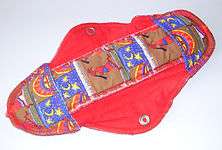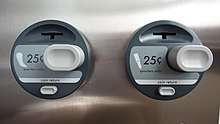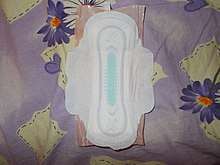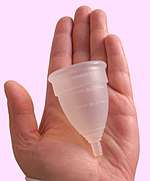Feminine hygiene
Feminine hygiene products are personal care products used during menstruation, vaginal discharge, and other bodily functions related to the vulva and vagina. Those products that are used during menstruation may also be called menstrual hygiene products. Products used may include sanitary napkins (American English) or sanitary towels (British English), tampons, pantyliners, menstrual cups, and period panties. Feminine hygiene products also include products meant to cleanse the vulva or vagina, such as douches, feminine wipes, and soap.
Feminine hygiene products are either disposable or reusable. Sanitary napkins, tampons, and pantyliners are disposable feminine hygiene products. Menstrual cups, cloth menstrual pads, period panties, and sponges are reusable feminine hygiene products.[1]
Feminine hygiene products that are meant to cleanse may lead to allergic reaction and irritation, as the vagina naturally flushes out bacteria.[2] Many health professionals advise against douching because it can change the balance of vaginal flora and acidity.[3]
Types
Menstrual hygiene products



Disposable:
- Pantyliner: Sticks to the inside of underwear to absorb blood and uterine lining during menstruation, sometimes worn with a tampon or for light discharge.[4][5]
- Sanitary napkin (Pad): Can be worn on the inside of underwear to absorb a heavier menstrual flow. Available in many different absorbencies and lengths, with or without wings.[6][7][8]
- Tampon: Worn inside the vagina to absorb menstrual blood, can also be worn while swimming. Available in different levels of absorbencies.[9][10][11]
Reusable:
- Menstrual cup: Worn inside of the vagina to catch blood/uterine lining. [12]
- Cloth menstrual pad: Word inside of underwear.[13]
- Period panties: Absorbent underwear.[14]
- Menstrual sponge: Inserted like a tampon or cup and worn inside the body.[15]
Risks
The different products may carry some health risks, some of which might be proven, others speculative.[20][21][22][23]
- Toxic Shock Syndrome: A rare illness that may occur when tampons are worn for long periods of time, although not directly linked to tampon use but caused by poison linked to bacteria of the Streptococcus pyogenes or Staphylococcus aureus type.[24][25]
- Irritation: Can be caused by fragrances, neomycin (adhesive on pads), tea tree oil, benzocaine. Inflammation can also be a risk associated with some products.[26]
- Yeast infection: A fungus.[27]
Society and culture
In low-income countries, women's choices of menstrual hygiene materials are often limited by the costs, availability and social norms.[28][29]
Costs and tax

Tampon tax is a shorthand for sales tax charged on tampons, pads and menstrual cups. The cost of these commercial products for menstrual management is considered to be unacceptably high for many low-income women. At least half a million women across the world do not have enough money to adequately afford these products. This can result in missing school or even dropping out. Several initiatives worldwide advocate to eliminate the tax all together. In some countries, such petitions have already been successful (for example parts of the UK and the United States).[30][31][32]
Many people believe the tampon tax should be abolished because tampons are a necessity for women. They consider the tax discriminatory because things like prescription drugs and condoms are not taxed. Lawmakers around the country have started to take notice. Many have taken measures to exempt menstrual hygiene products from the sales tax. Some lawmakers have even succeeded.[33]
Access to products in prisons
The Federal bureau of Prisons in the United States announced that women in its facilities would be guaranteed free menstrual pads and tampons. In section 411 of the First Step Act which was passed on May 22, 2018 states, "The Director of the Bureau of Prisons shall make the healthcare products described in subsection (c) available to prisoners for free, in a quantity that is appropriate to the healthcare needs of each prisoner".[34]
Other social views
For those with autism, using pads before menstruation begins may help reduce sensory issues associated with menstrual hygiene products. Prior education and practice may help familiarize an individual with body changes and the process of using products associated with menstruation.[35]
Menstruation may occur despite paralyzation; product use depends on the individual's personal preference.[36]
Some girls and women may view tampons and menstrual cups as affecting their virginity even though they have not engaged in sexual intercourse.[37]
History
See also
References
- Nicole, Wendee (March 2014). "A Question for Women's Health: Chemicals in Feminine Hygiene Products and Personal Lubricants". Environmental Health Perspectives. 122 (3): A70–A75. doi:10.1289/ehp.122-A70. PMC 3948026. PMID 24583634.
- "Feeling Fresh". kidshealth.org. Retrieved 2018-11-07.
- "Douching | Womenshealth.gov". womenshealth.gov. 2017-02-21. Retrieved 2018-11-07.
- Schaefer, Valorie Lee, et al. The Care & Keeping of You 1: The Body Book For Younger Girls. American Girl, 2018.
- Natterson, Dr. Cara, and Josée Masse. The Care and Keeping of You 2 The Body Book for Older Girls. American Girl Publishing, 2012.
- Schaefer, Valorie Lee, et al. The Care & Keeping of You 1: The Body Book For Younger Girls. American Girl, 2018.
- Stewart, Elizabeth Gunther. (2002). The V book : a doctor's guide to complete vulvovaginal health. Bantam Books. ISBN 9780307492449. OCLC 773813783.
- Natterson, Dr. Cara, and Josée Masse. The Care and Keeping of You 2 The Body Book for Older Girls. American Girl Publishing, 2012.
- Schaefer, Valorie Lee, et al. The Care & Keeping of You 1: The Body Book For Younger Girls. American Girl, 2018.
- Stewart, Elizabeth Gunther. (2002). The V book : a doctor's guide to complete vulvovaginal health. Bantam Books. ISBN 9780307492449. OCLC 773813783.
- Natterson, Dr. Cara, and Josée Masse. The Care and Keeping of You 2 The Body Book for Older Girls. American Girl Publishing, 2012.
- Rabin, Roni Caryn (2019-07-16). "A Better Way to Manage Your Period? Try the Menstrual Cup, Scientists Say". The New York Times. ISSN 0362-4331. Retrieved 2019-11-03.
- "Cloth menstrual pad", Wikipedia, 2019-10-21, retrieved 2019-11-18
- "How Do I Use Tampons, Pads, Period Underwear & Menstrual Cups? | Facts & Info". www.plannedparenthood.org. Retrieved 2019-11-18.
- Kim, Naeun (2015-11-10). "Soaking It Up With Menstrual Sea Sponges". Vice. Retrieved 2019-11-18.
- "What Is a Douche? Usage, Safety, and More". Healthline. Retrieved 2019-11-18.
- Stewart, Elizabeth Gunther. (2002). The V book : a doctor's guide to complete vulvovaginal health. Bantam Books. ISBN 9780307492449. OCLC 773813783.
- Benton, Emilia (2019-10-16). "These Are The Feminine Wipes Gynos Actually Recommend". Women's Health. Retrieved 2019-11-18.
- "Is It Safe to Use Soap? And 12 Other FAQs About Vaginal Health". Healthline. Retrieved 2019-11-18.
- "Are panty liners beneficial or harmful? I alternative to panty liners". UTI prevention I Vaginal care I Ezspur. Retrieved 2018-11-18.
- "Menstrual Cups: How to Use, Benefits, and More". Healthline. Retrieved 2018-11-18.
- "Cloth Pad Pros & Cons". Reusable Menstrual Products. 2016-11-23. Retrieved 2018-11-18.
- "Should We Really Be Using Feminine Care Wipes for Down There?". InStyle.com. Retrieved 2018-11-18.
- Stewart, Elizabeth Gunther. (2002). The V book : a doctor's guide to complete vulvovaginal health. Bantam Books. ISBN 9780307492449. OCLC 773813783.
- Natterson, Dr. Cara, and Josée Masse. The Care and Keeping of You 2 The Body Book for Older Girls. American Girl Publishing, 2012.
- Stewart, Elizabeth Gunther. (2002). The V book : a doctor's guide to complete vulvovaginal health. Bantam Books. ISBN 9780307492449. OCLC 773813783.
- Natterson, Dr. Cara, and Josée Masse. The Care and Keeping of You 2 The Body Book for Older Girls. American Girl Publishing, 2012.
- UNESCO (2014). Puberty Education & Menstrual Hygiene Management - Good Policy and Practice in health Education - Booklet 9. United Nations Educational, Scientific and Cultural Organization, Paris, France, p. 32
- Kaur, Rajanbir; Kaur, Kanwaljit; Kaur, Rajinder (2018). "Menstrual Hygiene, Management, and Waste Disposal: Practices and Challenges Faced by Girls/Women of Developing Countries". Journal of Environmental and Public Health. 2018: 1730964. doi:10.1155/2018/1730964. ISSN 1687-9805. PMC 5838436. PMID 29675047.
- "Could this be the first country to end 'period poverty'?". www.msn.com. Archived from the original on 19 April 2018. Retrieved 2 May 2018.
- Nosheena Mobarik (3 October 2018). "Mobarik: UK one step closer to ending the tampon tax". Conservatives in the European Parliament.
- "Women get their periods every month — and it's incredibly expensive". USA TODAY. Retrieved 2018-10-15.
- Ooi, Jorene (2018). "Bleeding Women Dry: Tampon Taxes and Menstrual Inequity".
- "Text - H.R.5682 - 115th Congress (2017-2018): FIRST STEP Act". 2018-05-23.
- Lyons, Tony. 101 Tips for the Parents of Girls with Autism : the Most Crucial Things You Need to Know About Diagnosis, Doctors, Schools, Taxes, Vaccinations, Babysitters, Treatment, Food, Self-Care, and More. ISBN 9781629148427. OCLC 1054370720.
- Farrell, Kate, et al. Period: Twelve Voices Tell the Bloody Truth. Feiwel and Friends, an Imprint of Macmillan Publishing Group, LLC, 2018.
- Stewart, Elizabeth Gunther. (2002). The V book : a doctor's guide to complete vulvovaginal health. Bantam Books. ISBN 9780307492449. OCLC 773813783.
- Stein, Elissa (2009). Flow : the cultural story of menstruation. St. Martin's Griffin. ISBN 9780312379964. OCLC 946560416.
- ONEILL, THERESE. (2018). UNMENTIONABLE : the victorian lady's guide to sex, marriage, and manners. BACK BAY Books LITTLE BRN. ISBN 0316357901. OCLC 1003312707.
- Stewart, Elizabeth Gunther. (2002). The V book : a doctor's guide to complete vulvovaginal health. Bantam Books. ISBN 9780307492449. OCLC 773813783.
External links


